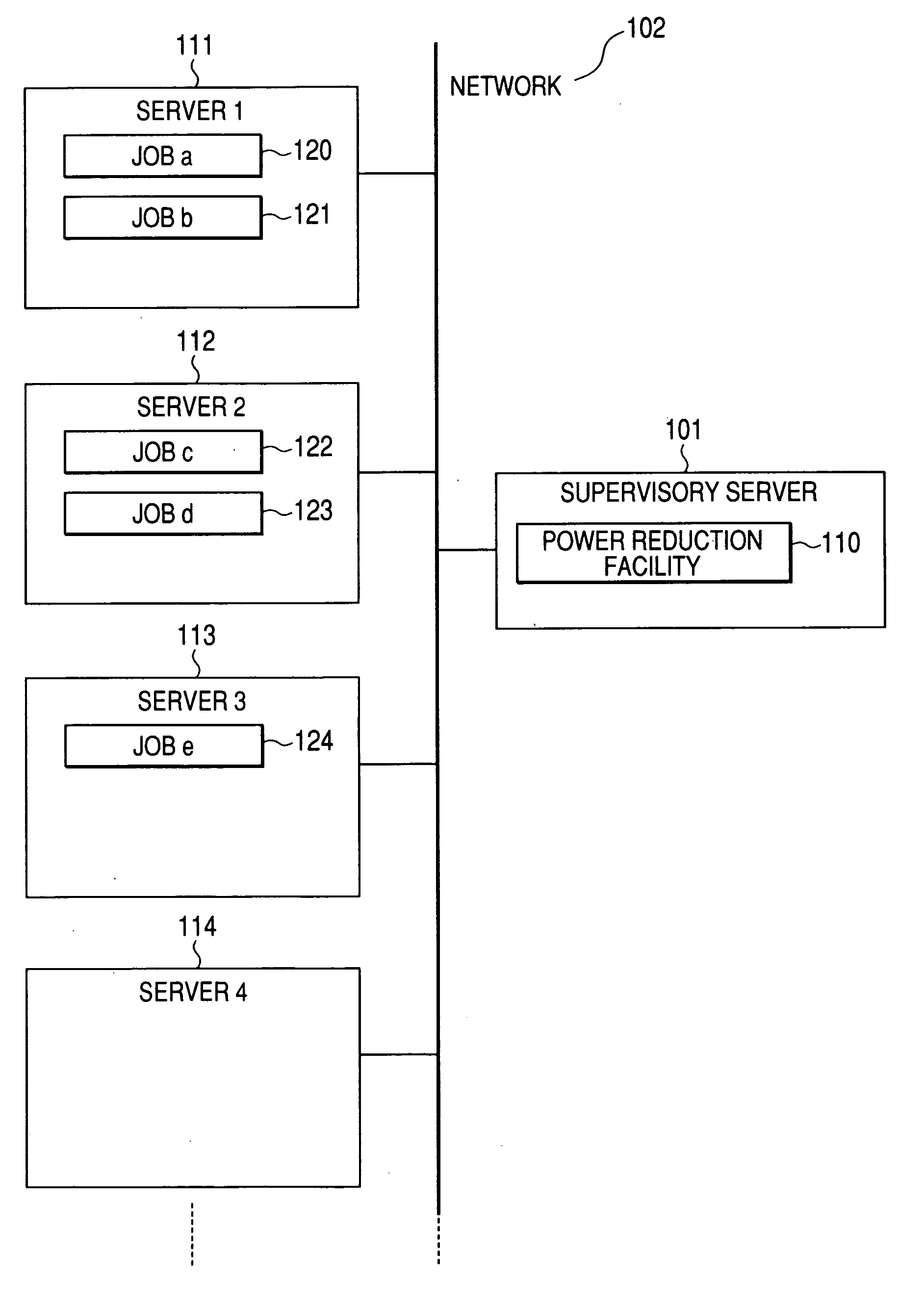Method and computer program for reducing power consumption of a computing system
a computing system and power consumption technology, applied in multi-programming arrangements, liquid/fluent solid measurement, instruments, etc., can solve the problems of reducing performance, unable to reduce the cost required for supplying power to unable to reduce the power consumption of the whole computing system, so as to reduce the power consumption
- Summary
- Abstract
- Description
- Claims
- Application Information
AI Technical Summary
Benefits of technology
Problems solved by technology
Method used
Image
Examples
embodiment 1
[0047]In the following, illustrative embodiments of the present invention will be described with the drawings.
[0048]FIG. 1 shows an overall structural diagram of a computing system according to a first embodiment of the present invention. The computing system of the present embodiment comprises a plurality of servers 111-114 and a supervisory server 101. The servers 111-114 and the supervisory server are interconnected through a network 102. On the servers 111-114, jobs 120-124 are running. However, a server with no job running on it may exist like a server 114. In the figure, the jobs 120-124 are particularly appended with identifiers like Job a and Job b, if their contents are different.
[0049]Here, the jobs 120-124 are generic terms used to refer to programs which perform processing in response to an input and returns an output. A job may be, for example, an application program, EJB® application, Java® application, and one of processes running in an OS (Operating System). Furtherm...
embodiment 2
[0075]A second embodiment (Embodiment 2) of the present invention is a method for intensive allocation of jobs to a subset of the servers, based on an event triggering the power reduction procedure by the power reduction facility 110 in Embodiment 1. A combination of the second embodiment and any other embodiment can be regarded as one embodiment of the present invention.
[0076]FIG. 20 shows details of the power reduction facility 110A in the second embodiment. Difference from Embodiment 1 lies in that the power reduction facility is provided with a trigger event detecting facility 420 which detects what event triggers the procedure of the invention illustrated in FIG. 7 in Embodiment 1. The trigger event detecting facility 420 detects one of the trigger events as will be specified below and starts the procedure illustrated in FIG. 7 in Embodiment 1. The trigger events are addition and removal of a server to / from the computing system; addition and removal or completion of a job, chan...
embodiment 3
[0077]A third embodiment (Embodiment 3) of the present invention is a method of obtaining server power properties from a power property measuring function installed in each server in the server properties obtaining function in Embodiment 1. A combination of the third embodiment and any other embodiment can be regarded as one embodiment of the present invention.
[0078]FIG. 21 shows an overall structural diagram of the computing system in Embodiment 3. Difference from Embodiment 1 lies in that each server 111A-114A is provided with a power property measuring function 2101. The power property measuring function 2101 can measure performance that the server utilizes (utilization performance) and the amount of power consumed by the whole server at the time as well as the amount of power consumed by each of its components and can report its measurement values to the power reduction facility 110.
[0079]FIG. 22 shows a detailed structure of each server 111A-114A in the third embodiment, wherei...
PUM
 Login to View More
Login to View More Abstract
Description
Claims
Application Information
 Login to View More
Login to View More - R&D
- Intellectual Property
- Life Sciences
- Materials
- Tech Scout
- Unparalleled Data Quality
- Higher Quality Content
- 60% Fewer Hallucinations
Browse by: Latest US Patents, China's latest patents, Technical Efficacy Thesaurus, Application Domain, Technology Topic, Popular Technical Reports.
© 2025 PatSnap. All rights reserved.Legal|Privacy policy|Modern Slavery Act Transparency Statement|Sitemap|About US| Contact US: help@patsnap.com



